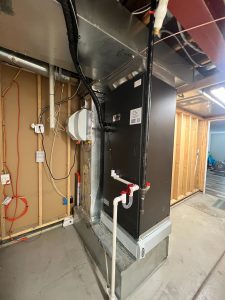Rule 1: Don’t Burn Stuff
Last week, we introduced the Climate-Friendly Home and outlined how it can help people make a real difference as we face the climate crisis head-on. ICYMI—Elephant has 3 simple rules to achieving a climate-friendly home:
- Don’t burn stuff.
- Don’t buy energy made from burning stuff.
- Be efficient.
Today, we’re digging into rule number 1: Don’t burn stuff. Read on to learn more about what that means, and what it looks like to adapt your home to this rule.
What “Don’t Burn Stuff” Means
Humans have been burning stuff to power our lives and homes for half a million years. We burn stuff to stay warm. We burn stuff to cook our food. We burn stuff to power our vehicles.
Burning stuff produces fossil fuels which fuels global warming…you get the picture.
Friends, it’s 2023! We’ve gotta stop burning stuff. Our ability to solve the climate crisis depends upon it.
What does that look like though? Put simply, we can replace every appliance in our home with something that doesn’t burn stuff. And the best part? We’re not asking you to make any trade-offs.
In every case, the modern electric version works even better than the crusty old fossil-fueled dinosaur that’s being replaced (harsh but true).
What “Don’t Burn Stuff” Looks Like in Your Home
Ready for some great news? We already have all the solutions we need to make a burn-free home a reality. And the technology is not even all that new.
For instance, take heat pumps. The origins of today’s heat pump technology can be traced back to the 1800s. Millions have been sold all over the world, and they’re used in all climates–even very cold ones (think Norway, Netherlands, and Finland).
You might have heard that heat pumps are magic (and we concur). That’s because they work as both an air conditioning unit AND a heater. Flip a switch, and instead of burning gas to heat your home (à la your furnace), a heat pump moves existing energy where you need it: into your home to heat it during the winter, and out of your home to cool it in the summer. And, they’re 3-5 times more efficient to boot.
But our “don’t burn stuff” rule goes beyond just switching to a heat pump. Let’s think about all the other things in your home that might burn stuff (in other words, anything that runs on gas right now). Here are some of the biggest culprits—and their burn-free swaps:
Burns Stuff |
Doesn’t Burn Stuff |
|
Furnace |
|
|
Water heater |
|
|
Gas clothes dryer |
|
|
Cooktop and oven |
|
|
Gas/wood fireplace |
“But wait!” you might say. “So WHAT if I go all-electric? I know that the electricity I’m putting into these machines just comes from a coal plant half the time anyway. So why bother?”
Well, THAT, folks, is a topic for next time. And don’t fret – there is a solution! In our next piece in this series, we’ll dig into the second rule of having a climate-friendly home: “Don’t use energy made from burning stuff.”
—
Excited to start transitioning away from burning stuff and towards cleaner, climate-friendly technology? That’s great! If you’re unsure where to begin, we’ve got you covered with our tool, Your Electrification Roadmap®. Answer a few quick questions about your home and goals and, in five minutes or less, you’ll have a unique-to-you roadmap that shows you exactly where to start.